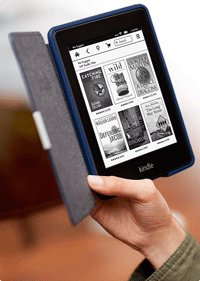Many people say they prefer to read actual books rather than e-readers or tablet computers, such as the Kindle, Nook or iPad. But for older adults, reading text on digital devices requires less effort than reading on paper, according to researchers in Germany published in the open access journal PLoS One.

Photo: Amazon.com
The researchers surveyed both young and old adults, and both groups stated a strong preference for paper books. But when researchers compared eye movements and brain activity measures, older adults fared better with backlit digital readers like tablet computers.
Younger adults didn’t demonstrate this effect. Specifically, the researchers found that younger readers between the ages of 21 and 34 showed similar eye movements and EEG measures of brain activity when tested on an iPad, a Kindle or paper.
Older adults, aged 60 to 77 years, spent less time fixating the text and showed lower brain activity when using a tablet computer. The study concludes that this effect is likely due to better text discrimination from the enhanced contrast on the backlit displays on electronic reading devices.
“The greater contrast and nearly ideal lighting makes for a better reading experience,” agrees optometrist and low vision specialist Richard Driscoll, who recommends e-readers both personally and professionally. “No matter what position you hold a backlit e-reader, the lighting is always good and the contrast can be adjusted to suit the reader—which is usually one of high contrast.”
Dr. Driscoll says paperbacks are usually printed on “marginal quality” paper, which offers lower contrast than can be achieved with an e-reader.
“The ability to increase the font size on a tablet or e-reader also improves readability,” he says.
For low vision patients, the iPad is a good choice because its bigger screen allows a greater font size. But for typical readers, devices like the Kindle or Nook work well. “Overall, I don't like the iPad as much as an e-reader because it is too big and heavy to hold. However, the iPad’s larger screen outweighs that limitation for the low vision patient,” Dr. Driscoll says.
Kretzschmar F, Pleimling D, Hosemann J, et al. Subjective impressions do not mirror online reading effort: Concurrent EEG-eyetracking evidence from the reading of books and digital media. PLoS One. 2013;8(2):e56178. doi: 10.1371/journal.pone.0056178. Epub 2013 Feb 6.

